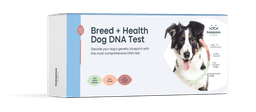While walking with your dog, it’s important to ensure a comfortable yet supported handhold. Some dog owners prefer a collar and lead combination, however, for those who want a pain-free grip and extra support, measuring a dog for the perfect fit harness is critical.
A step in dog harness is unique safety equipment that helps a person comfortably grip and control their dog. It is also a handy, invaluable tool when training your pup, especially in reducing lunging, jumping, and pulling. Plus, it is far better than traditional holders as it evenly distributes the leash pressure, reducing the stress and pain around the dog's neck.
But here's one crucial thing. All these benefits only come if your dog has a perfect-fit harness. But how will you know how to take your dog's fitting measurements? Let's see in detail.
How To Measure A Dog For A Harness
In general, harness sizing and fitting are typically determined by measuring the circumference of a dog's chest and neck. As such, generally, only these measurements must be taken precisely to ensure a perfect fit for all dogs.
Step-By-Step Guide
You need to note down a few key measurements to measure a dog for a harness and get its perfect fit. Fortunately, taking measurements of your dog's parts is a simple procedure. Those measurements are compared to a universal chart when identifying the correct style and size.
Prepare All You Will Need
Firstly, gather your supplies for taking measurements. For this, most probably, you require:
A soft tape
A partner, friend or family member to keep the dog still in place
Dog treats
Measure Your Dog's Chest Girth
The chest circumference is the widest part of a dog's chest, comprising the rib cage. Measuring it is the most important thing when buying the proper chest harness for dogs.
To measure it, wrap the measuring tape around your dog's chest circumference while standing. Remember, the tape should not be pressed too deeply. There must be a space to slide two fingers between them.
Measure Your Dog's Neck Circumference
After the chest, the second critical measurement is the dog's neck. For this, you must wrap the measuring tape around the dog's neck, starting in the region where the collar usually sits. Wrap up and take the measurement close to the dog's shoulders.
Compare Their Measurements To The Product Size Chart
After noting down chest and neck measurements, look for a product's size guide or chart on the seller's website. Always choose and buy the best, perfect-fitting harness for your dog's maximum comfort and support.
How Tight Should A Dog Harness Be?
Undoubtedly, determining the large dog body harness is quite a difficult task. A tight harness may cause your dog pain, discomfort, and harm. A loose one could let your dog escape from the harness quickly. Thus, it is a case of doing a balancing act. Try different options and check which one is the most comfortable for your dog while providing a reliable hold.
Conclusion
Indeed, buying a perfect-fit harness is more challenging a task than it seems. However, whatever harness you choose to buy, make sure you make a significant investment. Once you know how to measure a dog for a harness correctly, you can take measurements, compare them to a sizing chart, and buy the best one. After choosing the proper harness, it’s time to introduce your dog to it in a very calm manner.
Frequently Asked Questions
How should a dog harness fit?
As a general rule of thumb, take a step in a dog harness with a decent space, enabling you to fit two fingers between the dog's body and the harness.
What are the main parameters when you measure dog for harness?
The main parameters to measure a dog for a harness typically include the neck circumference, chest circumference, and sometimes the length from the base of the neck to the base of the tail.



